Syngonium Albo, a member of the Araceae family, the tropical plant species Syngonium with its characteristic arrow-shaped leaves that are typically green with white or cream variegations can be considered a great choice as an addition to your indoor plant collection.
The beauty of these plants is equally matched by their trainability over moss poles or trellis, and a great choice for hanging baskets. A no-fuss plant that prefers humidity, and bright indirect light but can equally thrive in lower and drier air.
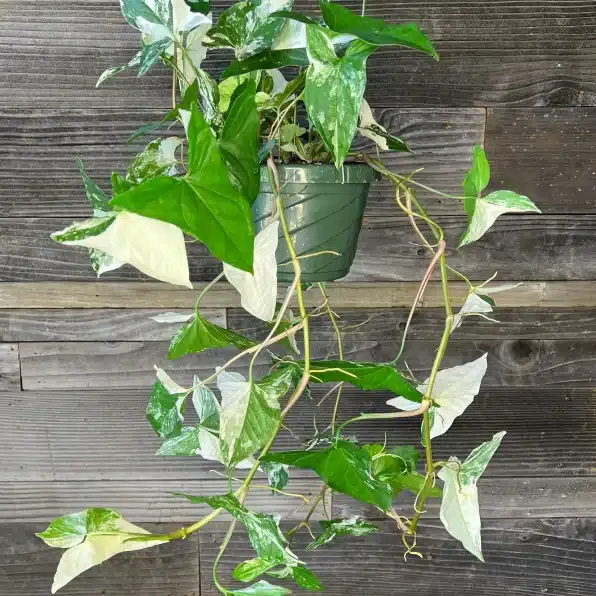
With the right care and light maintenance of this plant, you can have a vibrant healthy plant that brings beauty and joy to your home.
All About the Syngonium Albo Plant
Syngonium Albo is a tropical plant, native to Central and South America where it grows as an epiphyte up through the rainforest canopy. In the wild, it can climb to the tops of the tallest trees, but indoors and managed, its invasive tendencies can be tamed.

Reaching upwards to heights of 6.5 ft Syngonium Albo can create a striking impression in your house plant collection. Their leaves are typically between 3-5 inches long and 2-3 inches wide, arrow-shaped, and variegated, with contrasting green and white coloring.
The popularity of Syngonium is due to its appearance but also because of the relatively easy care requirements. It does well in low light and dry air but will thrive in bright, indirect light and high humidity.
Syngonium Albo has the ability to change the shape of its leaves as it matures. Young leaves are typically arrow-shaped, while more mature leaves can become more complex and divided, with multiple lobes and leaflets.
One interesting fact about Syngonium albo is that it is considered a semi-hydroponic plant. This means that it can grow in a special type of pot that allows the roots to be submerged in water, which can help to improve humidity levels around the plant.
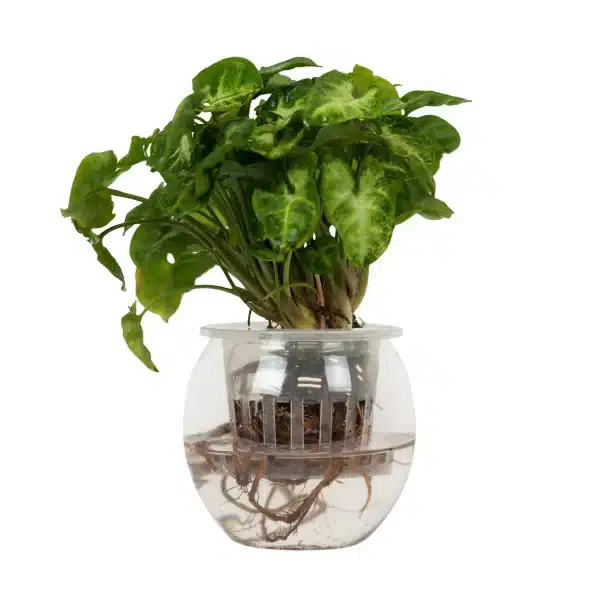
Albo Syngonium Plant Basics
| Common Name: | Arrowhead Plant, Arrowhead Ivy |
| Botanical Name: | Syngonium podophyllum ‘Albo Variegatum’ |
| Plant Type: | Tropical |
| Size: | 6 feet tall as a houseplant |
| Light: | Bright indirect sunlight, airy |
| Soil: | Rich, quick draining, loamy, pH 5.5 to 6.5 (mildly acidic) |
| Water: | Water if the top inch of soil is dry |
| Vulnerabilities: | Most common houseplant pests |
| USDA Growing Zones: | 9a, 9b, 10a, 10, 11 |
How Do You Take Care of Syngonium Albo Plants?
Syngonium Albo is a popular houseplant due to the ease of care, and a perfect first plant for a beginner. To make the most of this beautiful plant let’s look at what is involved in caring for the Syngonium Albo.

Soil Guide
The ideal soil for Syngonium is rich and high in organic matter. A combination of peat moss, vermiculite, and organic matter is a perfect combination. Look for a soil pH of 5.5 – 6.5 for the best results.
Well-draining soil is essential, Syngonium has a low tolerance for waterlogged soil. To avoid any issue with root rot, you can add a mixture of perlite into your potting soil to help with drainage.
Watering Needs
Syngonium albo prefers to be kept consistently moist, but not overly wet. Overwatering can lead to root rot and other issues, so it's important to avoid letting the plant sit in water for extended periods of time.
Water frequency depends on the size of the pot, the time of the year, and the light and humidity where the plant is located. A general rule of thumb is to water Syngonium when the first inch of the plant's soil feels dry. When you do water, water deeply to allow the water to penetrate the roots.
Lighting
Syngonium albo prefers bright, indirect light, but can also tolerate lower light levels. Direct sunlight can scorch its leaves, so it's best to keep the plant out of the direct sun.
Placing your Syngonium near a window that gets bright indirect but filtered light would be a good location. For example, a window with sheer curtains mimics the dappled light of the forest.

If the plant is not getting enough light, its leaves may become pale or turn yellow. If it's receiving too much light, its leaves may develop brown, crispy edges.
Syngonium can also be grown under artificial lights if there is no way for it to receive natural light.
Temperature & Humidity Levels
Syngonium albo prefers warm and humid conditions, similar to its native environment in tropical rainforests. Ideal temperatures for this plant are between 65°F to 85°F (18°C to 29°C).
Temperatures that are below 60°F (15°C) can stress the plant resulting in slowed growth, and temperatures above 90°F (32°C) can cause damage to the leaves.
Humidity should be 60% or higher and can be regulated with a humidifier or trays or water features near the plant. Misting the leaves can also help to increase the humidity levels.
Fertilizing the Plant
Syngonium benefits from regular feeding during its growing season (spring and summer), but it is not considered a heavy feeder. A diluted balanced fertilizer applied once a month should be sufficient to promote healthy foliage and growth.

Organic compost or a slow-release type fertilizer can be used for a once-a-year application. Be careful not to over-fertilize and during the plant's dormant season (fall and winter) stop fertilizing altogether.
Pruning Method
Pruning is an important part of Syngonium albo care, as it can help maintain the plant's shape, promote bushier growth, and remove any damaged or diseased foliage.
You can also prune back the tips of the plant's stems to encourage bushier growth. Simply cut back the stem to a healthy node, which is where a leaf joins the stem. This will stimulate new growth and help the plant become more full and bushy.
It's important to clean your pruning tools with rubbing alcohol before and after pruning to prevent the spread of disease.
Plant Propagation
Propagating the Syngonium by stem cutting is the easiest method and should be done during its growing season (spring and summer).
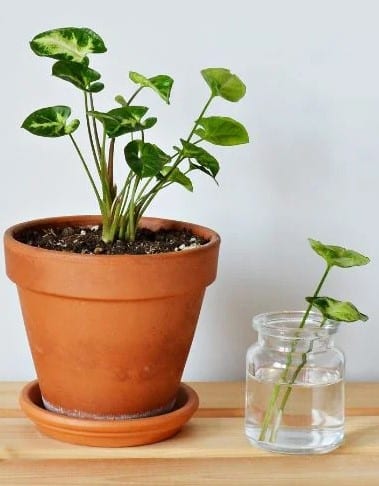
Stem Cuttings:
- Select a healthy stem with several leaves attached.
- Using a clean, sharp pair of scissors or pruning shears, make a clean cut just below a node (where a leaf meets the stem).
- Remove the lower leaves, leaving only two or three at the top of the stem.
- Place the cutting in a glass of water or a pot filled with moist potting mix. Using a rooting hormone and placing them directly into a rich potting mix will work as well.
- Keep the cutting in a warm, humid location with bright, indirect light.
- Roots should start to form within a few weeks. Once the roots are established, the cutting can be potted up in soil.
Similar Syngonium AlboPlant Varieties
- Syngonium podophyllum ‘White Butterfly': This variety has white or cream variegation on its leaves, similar to Syngonium albo. However, the variegation is more mottled and irregular, and the leaves are typically smaller and more heart-shaped.
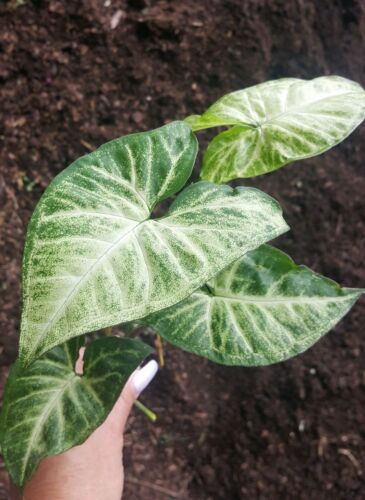
- Syngonium erythrophyllum ‘Red Arrowhead': Another variety with arrow-shaped leaves that are green with a reddish-pink tint, giving them a unique and striking appearance.
- Syngonium rayii: This variety has velvety, dark green leaves with silvery-white veins, similar to Syngonium albo. However, the leaves are more heart-shaped and have a slightly different texture.
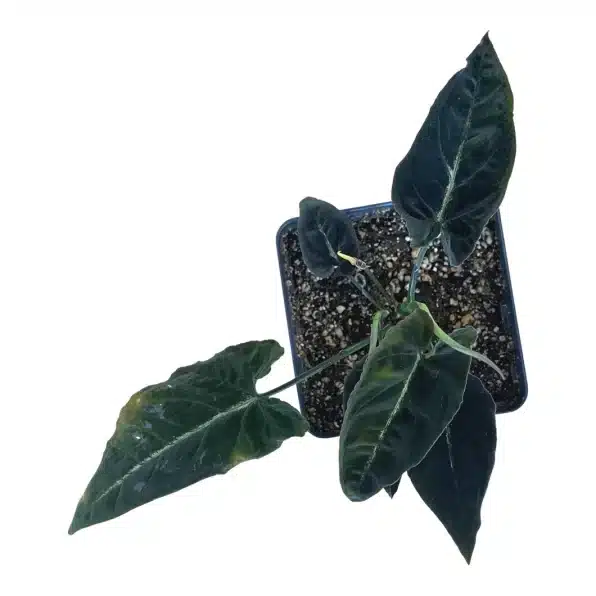
- Syngonium neon robusta: This variety has bright neon pink leaves that can add a pop of color to any space. The leaves are arrow-shaped and have a glossy texture.
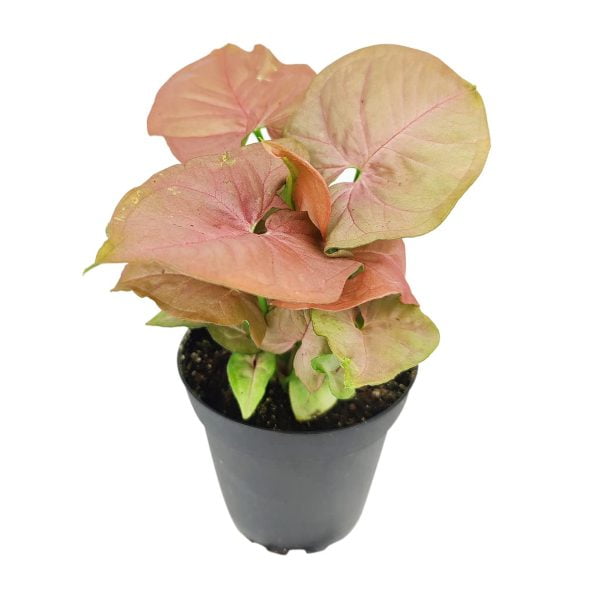
- Syngonium podophyllum ‘Maria Allusion': Having arrow-shaped leaves that are bronze-pink and dark green, similar to Syngonium albo. However, the variegation on this variety is more subtle and the leaves are smaller and more compact.
While there are definitive similarities there are often slight variations of soil preference, as well as the size of the plant overall.
Problems to Look for with Syngonium Albo
Like any houseplant, Syngonium albo can be susceptible to a variety of pests and problems. Here are some issues to look for:
Growing Issues
Growing issues are generally a sign that there is an issue with the soil, watering or light. Replanting and repotting may help by changing and adding a richer, more fertile soil. There may also be a lighting issue, as the Syngonium prefers bright, indirect light, relocation may help with any growing issues. Overwatering can cause growth issues and leaf yellowing can occur. Adding porous material to your soil may help.
Diseases
Bacterial and fungal disease are common problems with the Syngonium, generally treatable if caught early. Overwatering can create the environment for these types of fungus and bacteria to grow.
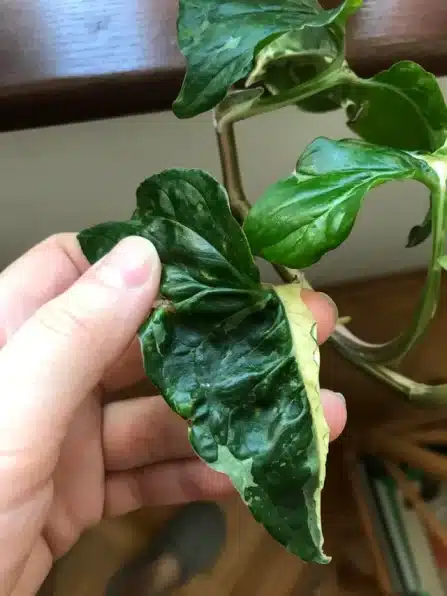
Pests
Syngonium faces the same pest problems as do most indoor plants. Common pests include spider mites, mealybugs, and scale insects. These can be treated with insecticidal soap or neem oil spray.
Interesting Facts About the Syngonium Albo
Syngonium Albo are not just a decorative plant, they also act as an air purifier by cleaning pollutants out of the air.
The amount of light the Syngonium Albo receives can influence the variegation color of the leaves. Leaves that receive more light will have more of the white or cream-colored variegation on the leaves, while lower light can change the looks of the leaf completely.
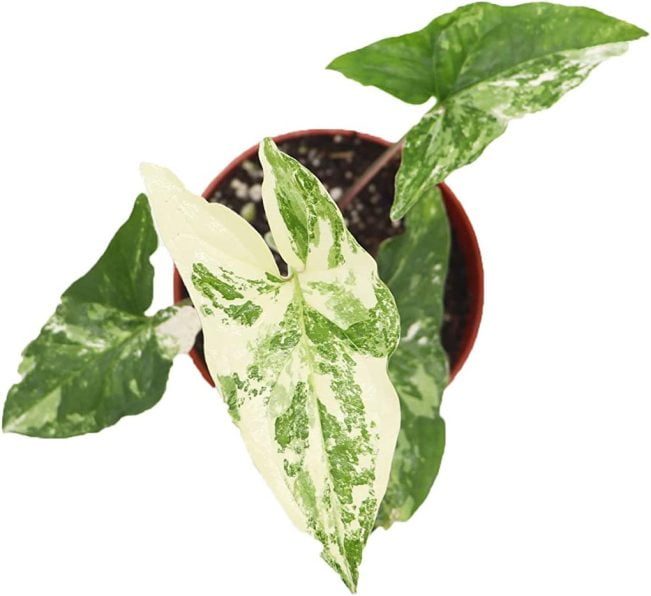
FAQ's
Are Syngonium Albo rare?
Syngonium Albo can be considered rare in the plant community due to its unique and highly desirable variegated foliage. Originating in Mexico, Bolivia, and Brazil, they may be difficult to find. Considered one of the hardest to find is the Syngonium Dwarf Variegata.
How fast does Syngonium Albo grow?
The growth rate of Syngonium Albo can vary depending on its growing conditions, but it generally grows at a moderate to a fairly rapid pace. With proper care, it can produce new leaves and increase in size throughout the growing season.
Why is my Syngonium Albo turning yellow?
There are several reasons why your Syngonium Albo may be turning yellow. Overwatering or underwatering can cause the leaves to turn yellow and wilt. Additionally, low light or sudden changes in temperature can stress the plant and cause its leaves to yellow. It's important to identify the underlying cause of the yellowing and adjust your care routine accordingly.
Can Syngonium Albo get too much light?
Yes, Syngonium Albo can get too much light. While it thrives in bright, indirect light, exposure to direct sunlight can damage your plant. It's important to find a location with bright, filtered light for your Syngonium Albo, and to protect it from direct sun rays.
What is the best way to propagate syngonium albo?
The best way to propagate this plant is to cut its stem during the growing season. The stem is then placed in water or soil until roots start to form, then transferred to pot or outdoor soil. See above for more details on propagating Syngonium albo.

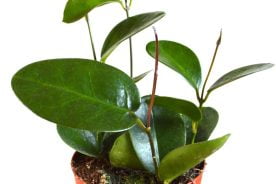
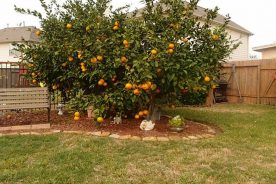
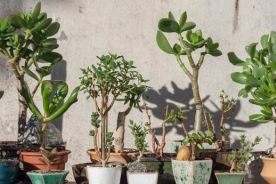

No Comments